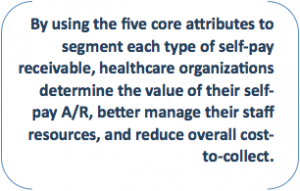Traditional methods to manage self-pay accounts are increasingly inadequate and fraught with failure. Here are four common mistakes providers make when processing self-pay receivables:
- Data quality – Deficient data integrity. Demographics and insurance information are missing or incorrect.
- Forecasting – Lack of receivables forecasting tools and analytics. Providers are unable to segment their self-pay received to determine a likely yield
- Compliance –Distraction created by federal and state bookkeeping requisites. Another day, another new requirement.
- Labor-intensive processes – Applying the same recovery tactics to each account. Labor is costly. Wasting valuable time on self-pay accounts that may never yield reimbursement is a lose-lose strategy.
For greater efficiency, and self-pay value, new approaches to managing self-pay accounts must be considered. There are simply too many accounts to continue using the same-old, inefficient process. One of these strategies is to score and prioritize your self-pay accounts.
Score and prioritize self-pay accounts
Understanding the five core attributes that affect reimbursement and account performance is the first step to successfully targeting staff resources and actively managing the revenue cycle. Self-pay accounts can then be segmented by score value. Based on those score values, managers are empowered to select the best pathway for maximizing value from their receivables.
5 core attributes that affect self-pay A/R performance

- Demographic Verification – Validate guarantor’s contact information
- Insurance Discovery – Search self-pay for hidden payor coverage
- Self-Pay Analysis – Define propensity to pay and who qualifies for financial assistance
- Insurance Verification – Ensure first claim adjudication—everytime
- Prior Authorization – Determine reimbursement requirements
For details about self-pay receivables and how to set a new A/R strategy, request a demo here.


